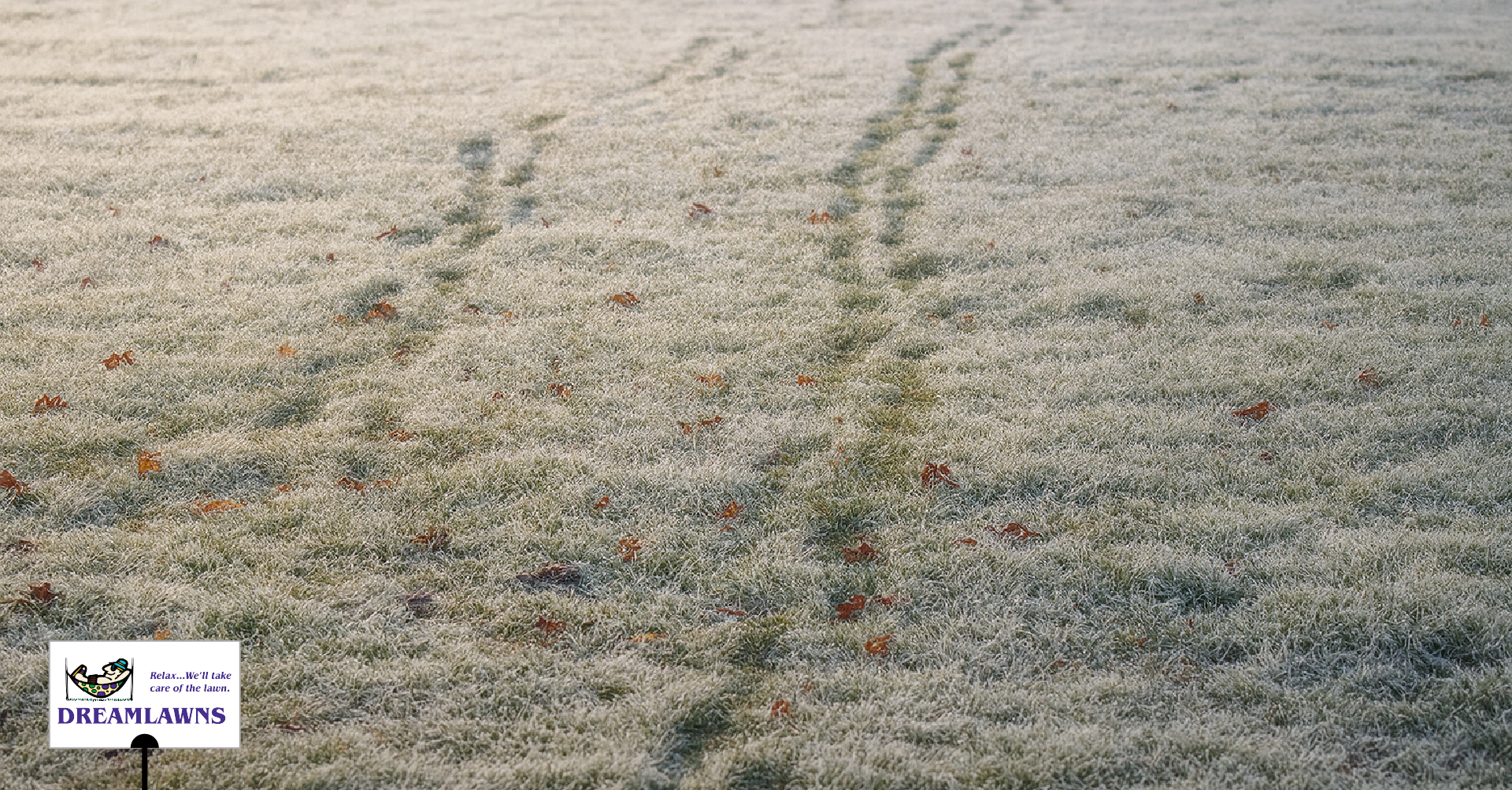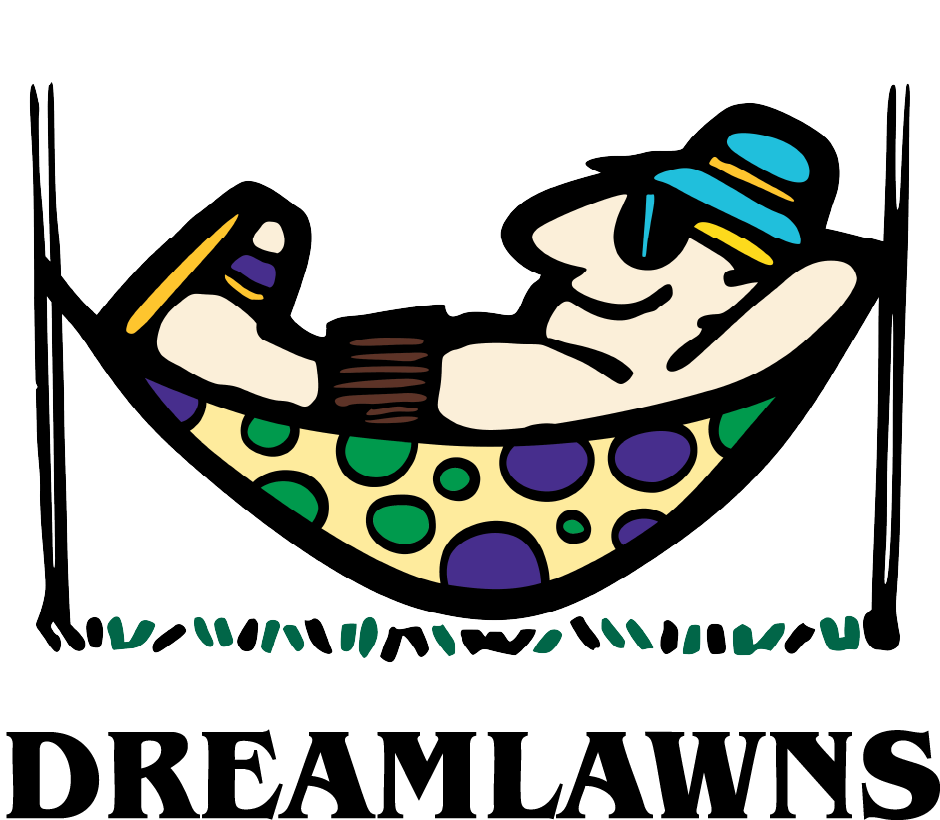
Dreamlawns Quick Cut: Frost may seem harmless, but it can weaken turf, leave lasting footprints, and create openings for weeds and disease in spring. Walking or mowing on frosted grass crushes brittle blades, causing brown patches that won’t heal until new growth returns. The best defense is prevention: avoid traffic on frosty mornings, keep your lawn properly fertilized, and follow smart lawn protection tips. Dreamlawns offers tailored winter lawn care programs in Virginia Beach to prevent frost damage and keep your turf healthy year-round.
As cooler nights arrive in Virginia Beach, frost becomes a familiar sight on rooftops, car windshields, and lawns. While it may look harmless, just a thin, silvery coating, frost can quietly stress your grass. Many homeowners don’t realize that repeated frost exposure weakens turf, leaving it vulnerable to footprints, thinning, and even spring weed problems.
The good news is that frost damage can be minimized with the right approach. By understanding how frost affects your lawn, avoiding common mistakes, and following a few smart winter lawn care practices, you can keep your turf healthier through the cold months and ready for strong growth in spring.
What Is Frost and How Does It Affect Your Lawn?
Frost forms on calm, clear nights when surface temperatures drop below freezing. The moisture in the air crystallizes directly onto grass blades, creating that familiar silvery coating you see on your lawn in the early morning. While frost itself doesn’t usually kill grass, it does stress turf in ways many homeowners overlook.
Here’s how frost impacts your lawn:
- Frozen Blades Become Brittle: The water inside grass cells freezes, making blades stiff and fragile.
- Repeated Freeze/Thaw Cycles Weaken Turf: Frost melts during the day and refreezes at night, stressing the grass and leaving it more vulnerable to thinning.
- Increased Disease Susceptibility: Weakened turf is less resilient to fungal diseases that can linger in cool, damp conditions.
- Slowed Growth in Fescue Lawns: Tall Fescue, common in Virginia Beach, stays semi-active in cool weather but becomes more sensitive to stress from frost.
Frost doesn’t mean your lawn is doomed, but ignoring it can cause long-term issues. Understanding this natural process is the first step in protecting your turf with smart winter lawn care practices.
Why Walking on Frosted Grass Causes Damage
Frost itself weakens turf, but the most visible injury happens when traffic is added to the mix. Grass blades coated in ice are brittle, and even light pressure can cause lasting damage. Common ways frost damage occurs:
- Walking Across the Lawn: Footsteps crush frozen cells, leaving brown trails or “footprints” that persist until new growth replaces the damaged blades.
- Mowing Too Early: Running equipment over frosted turf causes widespread injury, often across the entire lawn.
- Pet Traffic: Dogs or other pets running across frosty grass can create patchy areas that look burned.
- Objects Left Overnight: Toys, furniture, or garden tools left on the lawn press into frosted blades, leaving discolored patches.
Unlike summer stress, frost damage doesn’t heal quickly. Blades that turn brown after being crushed will stay that way until fresh growth emerges, often not until spring. That’s why one frosty morning of activity can leave months of visible scars on your lawn.
Lawn Protection Tips to Minimize Frost Damage
Frost is unavoidable in Virginia Beach during chilly fall and winter mornings, but damage from frost doesn’t have to be. By making a few simple adjustments, you can protect your turf and keep it healthier through the cold months.
- Avoid Traffic on Frosty Grass: Keep people, pets, and equipment off the lawn until frost has fully melted.
- Delay Mowing: Wait until later in the day when the grass has thawed before mowing. Cutting frosted blades causes tearing and long-term discoloration.
- Maintain Proper Mowing Height in Fall: Keeping grass slightly taller going into winter helps insulate crowns and reduces frost stress.
- Fertilize in the Fall: A strong root system is your lawn’s best defense against winter stress. Fall fertilization helps turf store energy for resilience.
- Monitor Soil Moisture: Watering is still important in dry autumn weather. Hydrated grass is better able to withstand frost and cold snaps.
- Clear Lawn Items Overnight: Don’t leave toys, furniture, or garden tools on the turf, as they can press into frosted blades and leave brown patches.
Like most things with lawns, taking preventive steps now is far easier and cheaper than trying to repair a lawn in spring after frost damage has already occurred.
How to Help Grass Recover After Frost Damage
Even with the best prevention, some frost damage is inevitable in Virginia Beach lawns. The good news is that most turf will recover, especially if you take the right steps to support it through winter and into spring. Here are some tips for helping your lawn bounce back:
- Be Patient with Minor Damage: Light footprints or discolored blades usually fade as temperatures warm and growth resumes in spring.
- Avoid Overwatering or Overfertilizing: Trying to “force recovery” in winter often backfires. Grass is semi-dormant, so keep care balanced and moderate.
- Monitor Thin Areas: Weakened turf may invite early spring weeds. Keep an eye out and address weeds quickly to avoid further stress.
- Support Strong Roots Now: Fall fertilization and proper mowing height give your lawn the energy it needs to repair itself once growth conditions return.
While you can’t erase frost damage immediately, consistent winter lawn care practices make sure your turf heals faster and comes back stronger.
Professional Help for Winter Lawn Care in Virginia Beach
Frost is a natural part of the season, but how much damage it causes often depends on how well your lawn is prepared going into winter. Many homeowners are surprised to learn that intentional or professional care in the fall and early winter is one of the best defenses against frost injury. Dreamlawns offers proven services tailored to Virginia Beach’s climate and soil conditions.
Here’s how our professional services strengthen your lawn against frost and anything else the seasons throw at it:
Fall Fertilization for Resilient Roots
Grass plants naturally slow top growth in cooler months and shift energy into their root systems. Our fall fertilization programs supply the nutrients your lawn needs to store energy, making it more resistant to frost stress and ready to green up quickly in spring.
Aeration and Overseeding for Thicker Turf
Thin lawns are more vulnerable to visible frost damage. Aeration relieves compaction and allows air and water to penetrate deeper into the soil, while overseeding thickens weak areas. A dense lawn insulates itself better and recovers faster from cold stress.
Customized Lawn Protection Tips
Every property is different. Shaded lawns may stay frosted longer, while sunny areas thaw more quickly. Our team provides site-specific advice on mowing heights, watering, and traffic patterns so your lawn gets care that matches its conditions.
Weed and Pest Prevention
Weakened turf from frost damage creates openings for weeds and pests in early spring. Our year-round programs include lawn weed control service and outdoor pest control strategies to prevent small problems from becoming major issues later.
Year-Round Lawn Care Programs
Frost is just one seasonal stressor Virginia Beach lawns face. With ongoing care, we ensure your turf is consistently protected, whether it’s from summer drought, fall weeds, or winter frost. By working with Dreamlawns, you’ll always have a plan in place for healthier turf.
Professional care doesn’t just prevent frost damage, it helps your lawn recover more quickly when cold weather takes its toll. With Dreamlawns, you get more than treatments, you get a trusted partner in keeping your yard strong and attractive in every season.
Protect Your Lawn from Frost This Winter
Frost is one of the most overlooked stressors for Virginia Beach lawns. While a thin coating of ice may look harmless, it can weaken turf, create long-lasting footprints, and open the door for weeds and disease in spring. The key to prevention is simple: avoid traffic on frosty mornings, follow smart lawn protection tips, and prepare your turf in the fall with the right professional care.
At Dreamlawns, we specialize in winter lawn care that goes beyond quick fixes. From fall fertilization to aeration, overseeding, and year-round weed control, our programs are designed to keep your lawn strong, resilient, and ready to thrive no matter the season.
Don’t leave your lawn exposed to frost damage. Contact us today to schedule services and protect your turf through winter and beyond.
Dreamlawns provides superior lawn care service to Virginia Beach & Chesapeake VA residents.




